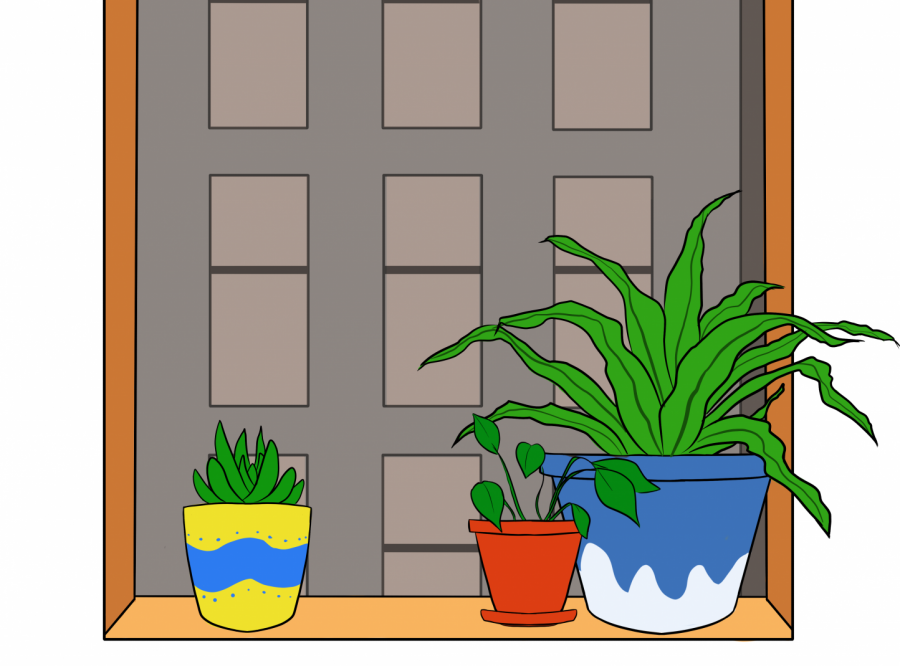Top 10 Houseplants (That Aren’t Succulents)
The best plants to survive dorm conditions and a busy college lifestyle.
Houseplants are growing in popularity, and for good reasons. They bring life and color to any room, filter the air, and have been known to make people happier and reduce stress. They also serve as functional decorations. Despite the positive impacts of owning plants can have, many people are hesitant to invest in a plant friend because they do not know how to keep it alive, or are worried that the plant would not be able to survive in their low-lit, cramped apartment.
Many people start out with succulents or cacti because of their extreme representation in the media as the easiest plant to have. However, these plants are actually very easy to kill because they are the most susceptible to root rot, which happens when a plant is watered too much and the soil does not dry out properly. The roots start to rot in the excess moisture, and it is irreversible, resulting in the plant’s death. Overwatering is the easiest and most common way to kill a houseplant.
This list is of the best plants, alternative to succulents, to start an indoor plant collection with, how to care for them, and what makes them special.
Snake Plant
Growing Conditions: Snake plants are the perfect beginner plants because they can survive in almost any condition. While they thrive best with high light and medium watering levels, they won’t object to overwatering, underwatering, or low light conditions.
Health Benefits: Snake plants filter out nasty chemicals like benzene, formaldehyde, trichloroethylene, xylene, and toluene, so you can breathe easy having this in your home.
Fun Fact: Another common name for snake plants is ‘mother-inlaw’s tongue,’ for it’s sharp edges.
Pothos
Growing Conditions: Pothos vines grow easily, even in low light conditions and dry air, making them perfect indoor plants. They are sometimes referred to as a ‘cubicle plant’ because it is known to survive just off of office lights alone.
Health Benefits: Pothos filters benzene, formaldehyde, xylene, and toluene from the air.
Fun Fact: You can propagate Pothos very easily by cutting off a section with three leaves, pinching off the bottom leaf, and putting it into a glass of water. Within weeks, you will have a whole new plant with its own roots system!
Dracaena
Growing Conditions: Dracaena adapts easily to varying light conditions, but actually prefers not to be in direct sunlight, which means its a great addition to any north or south facing windows you might have. They like to be watered moderately, but tend to have bigger pots so make sure you water enough per serving to saturate all the roots!
Health Benefits: When it comes to purifying the air, Dracaena Marginata is one of the best options. It removes benzene, formaldehyde, trichloroethylene, and xylene.
Fun Fact: Dracaena is actually a genus of plant, and there are several different species of dracaena that have different appearances and effects, but all of them make wonderful houseplants.
ZZ Plant
Growing Conditions: ZZ Plants thrive in low lighting conditions and are drought resistant, meaning if you forget to water them for a couple weeks, they will still be there. In fact, they really only need watering once a month.They act like succulents and store water in case of a ‘drought.’
Health Benefits: ZZ Plants transpire at a high rate, meaning that they can clean out airborne toxins fast. They remove the chemicals toluene and xylene from indoor air.
Fun Fact: Many cultures believe a ZZ Plant “symbolizes prosperity and friendship,” making it a great housewarming gift.
Spider Plant
Growing Conditions: Spider plants need high light levels, but do okay without direct sunlight, meaning they will do just fine indoors as long as they are near a west or east facing window.
Health Benefits: Spider plants are a strong air purifier, removing both formaldehyde and xylene.
Fun Fact: Spider plants get their name from the spidering ‘babies’ that grow from the ‘mother plant.’ These are miniature versions of the plant that can be pinched off once you see roots growing, and planted in their own pot to grow into a whole new plant.
Rubber Tree
Growing Conditions: Rubber trees are good at holding in moisture, so are okay with only being watered every so often. They need bright light though, so only get one if you have a big window with lots of sunlight. Don’t worry, they only grow as large as the pot you give them will allow. So, you can keep them as small as a foot tall, or you can let it grow up to five feet tall if you choose to put it in a larger pot.
Health Benefits: Being a tree, rubber trees are very good at taking carbon dioxide out of the air and filling your room with oxygen.
Fun Fact: Rubber trees have green leaves with red or purple undersides, so they can provide a very colorful addition to your home.
Philodendron
Growing Conditions: Philodendron is very similar to Pothos, but it is a trailing vine with heart-shaped leaves. It is low maintenance, requiring a water once a week or less, depending on the humidity in your home.
Health Benefits: Philodendron is not as great as the other plants in this list at purifying air, but it does filter formaldehyde!
Fun Fact: The tendrils of this vine will grow towards the brightest light source, so you can ‘guide’ the direction the vines will grow by placing the plant in specific spots around the window.
Alocasia
Growing Conditions: There are many species of alocasia, so they may have varying light requirements. When purchasing one, look for one that tolerates low light environments or shade, and it will thrive inside! They are a tropical plant, so they will like to be kept moist, but be sure to let the soil dry out every once in a while to avoid root rot. Depending on your home’s climate, this could mean watering one to two times a week to once every two weeks.
Health Benefits: Alocasia’s big leaves works hard to circulate the air and reduce the amount of toxins in the surrounding environment.
Fun Fact: The common name of Alocasia is ‘Elephant Ear,’ for the shape and size of the leaves. Some varieties of elephant ear can grow 5 feet wide leaves!
Top Tip:
Water properly! Water a lot, less often, rather than watering a little bit every day. Once a week or so, depending on your plant, move your plants to your sink or tub to soak the soil all the way through. Wait until the soil has dried out completely before watering again. You can test the soil by inserting your finger about an inch into it. If the soil is still moist within the top inch or so of soil, it is not time to water yet.














Bryce • Oct 26, 2020 at 4:49 pm
It would be great to have pictures to go along with each plant so I don’t have to go look them up myself. Thank you though for the information!